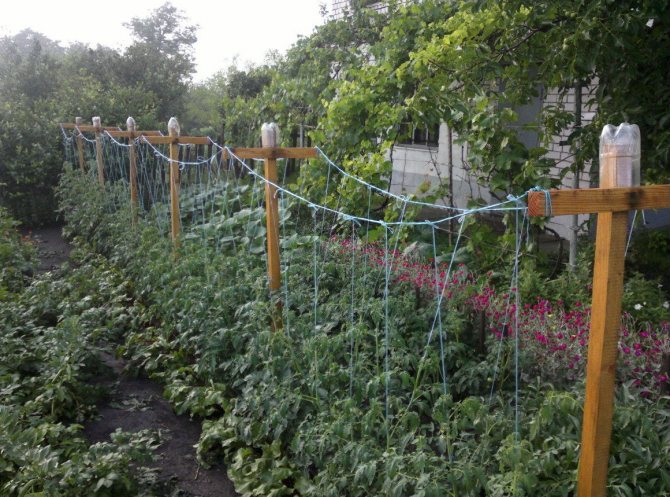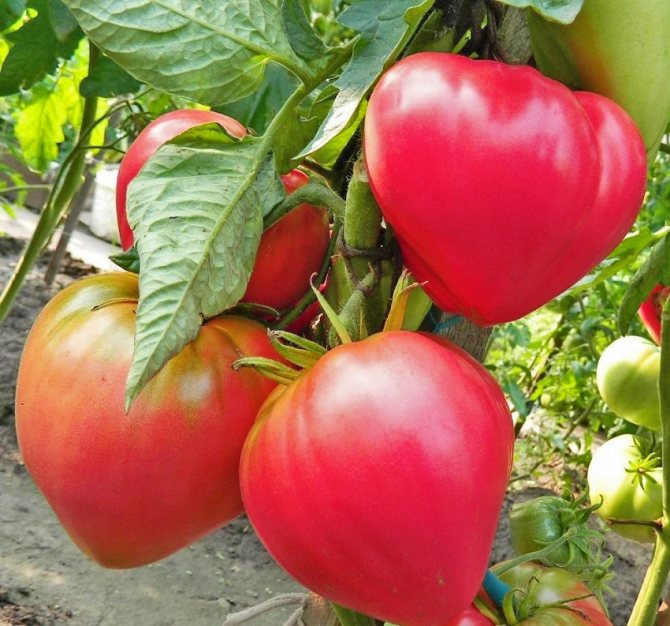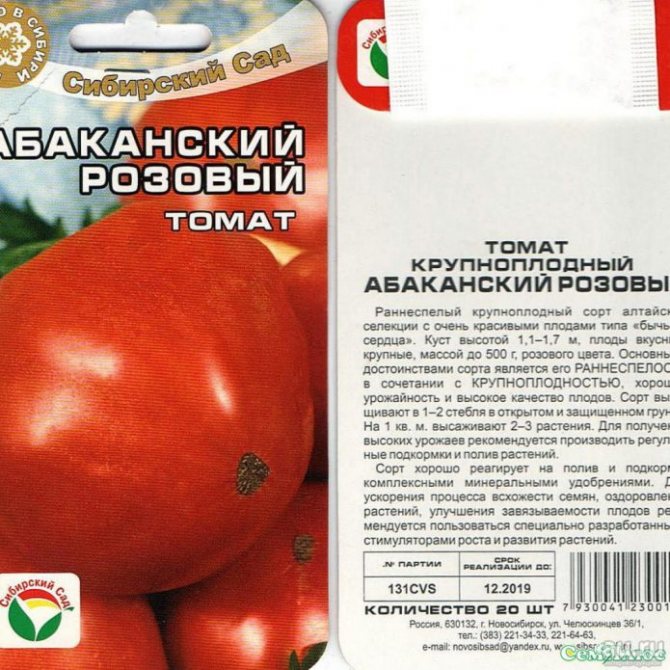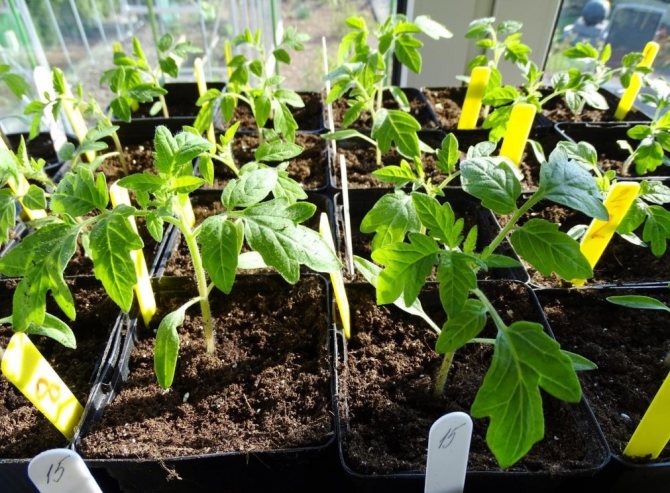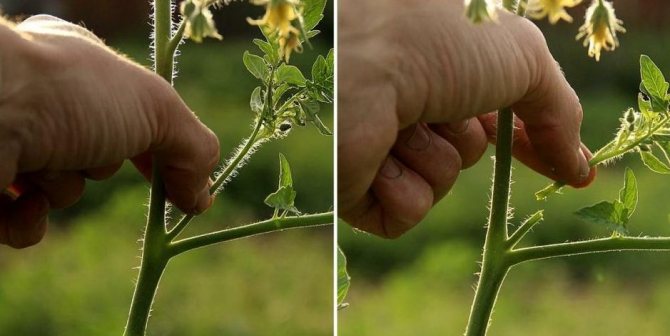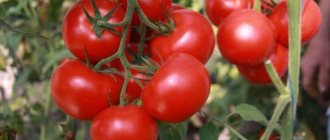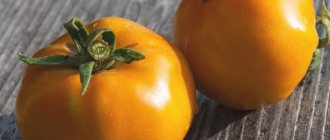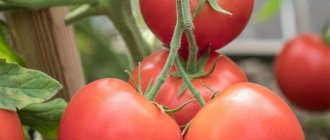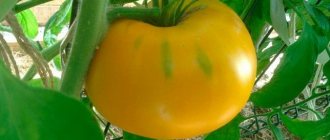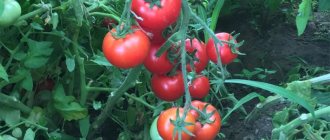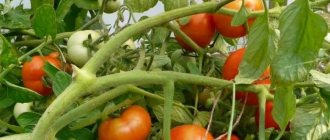I have been growing the Abakan Pink tomato variety on the site for the third year already. Before that I tried it in a greenhouse. However, in the open field, the fruits are much larger. I liked these tomatoes for their taste and the fact that I harvest almost the whole summer. Enough not only to eat, but also to make just great juice. I want to share what characteristic and description of the variety and why the Abakan pink tomato has become one of my favorites.

Brief information about the variety
- Fruit and bush: pink tomatoes. Weight - 500 g. Determinate bush, reaches 0.6-0.8 m in the open field, 130-150 cm - in greenhouses.
- Yield: up to 6 kg per bush.
- Sustainability: variety resistant to various diseases, moderately resistant to the Colorado potato beetle, tolerates cold climate well.
- Spread: all regions of Russia; in Siberia it is better to use greenhouses.
- Application: fresh consumption, preparation of juices and sauces, canning - rarely.
- Landing: seedling method. You can start in May according to the 40x60 scheme.
- The soil: nutritious and light.
- Care: watering - once a week, feeding - 3 times per season, pinching and garter - mandatory, shaping - 1-2 stems.
- Ripening period: ripens by August. Fruiting continues until the end of summer. Tomatoes are stored for up to 60 days.
Characteristics of the variety
Initially, the Abakan pink tomato was bred for cultivation in Altai (in the Siberian district). Due to its resistance to various negative factors, it often ends up in vegetable gardens. This variety tolerates low temperatures well.
In cold regions, it is recommended to grow it only in film shelters, but in areas where the climate is more temperate, it is allowed to plant tomatoes in open ground. In this case, they take root pretty well.
Description of the bush and fruit
Abakan pink tomato is a determinant plant of medium height. It reaches 130-150 cm in greenhouse conditions. In the open field, these figures are slightly less - 60-80 cm.
The inflorescences are of a simple type. The leaves are medium-sized and deep green in color. The degree of foliage is low.
The weight of the fruits reaches 500 g. If you provide the tomato with more careful care, it is possible to get larger fruits - 800-900 g. They have a heart-shaped shape and a slightly ribbed surface. The pulp is juicy, but not watery. The sugar content is up to 5%.
Productivity and fruiting
The growing season stretches for 115 days. The fruiting and productivity indicators of the variety are excellent. 5-6 tomatoes ripen on one brush.
Up to 5 kg of tomatoes are removed from 1 m² when grown in the open field. In greenhouse conditions, the yield increases by several kilograms.
Application
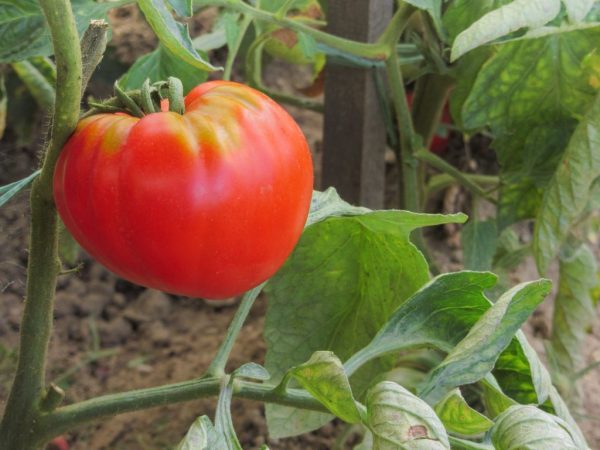

The fruits are delicious fresh
The Abakan pink tomato is a variety that is grown for the preparation of various salads. Tomatoes make good sauces. Juices are especially tasty, because the fruits of this variety are sweet.
It is used extremely rarely in canning due to the large size of tomatoes.
Disease and pest resistance
The variety, according to the description, has a fairly high level of resistance to various diseases, so give up the use of chemicals, but everything is not so simple with pests.
The Colorado potato beetle is the most dangerous for this variety, but it poses a threat only to newly planted plants and immature fruits. At these stages of plant development, it is necessary to carefully monitor them and provide them with reliable protection.
Storage and transportation
According to the description, tomatoes of this variety have fleshy flesh, but it can remain whole for a long time even with slight pressure, so they can be stored for a long time.
The fruits have a dense skin. It reliably protects them from damage, therefore, they tolerate transportation well, even if they are being transported for a long time.
Growing regions
The Abakan pink variety is suitable for growing in all regions of Russia, but each of them will have some nuances when growing. To get a richer harvest, you must take them into account.
In Siberia, tomato can only be grown in greenhouse conditions. In central Russia - both in greenhouses and in open areas. In this case, it is better to use film covers during the spring, and then remove them. On the territory of other regions, Abakan tomatoes can be safely planted in the open field.
Yield
The yield of Abakan pink is average. When 5 kg of tomatoes are harvested from a square meter, one does not speak of huge yields. But if you consider that this is not a hybrid, then the result is quite decent.
The relatively low yield is compensated by the extended fruiting and excellent taste of the fruits, because of which, in principle, the variety is bred.
The return from a tomato increases with the systemic use of fertilizers:
- urea;
- potassium sulfate;
- superphosphate.
Irrigation affects the yield, Abakan pink responds very well to them.
Advantages and disadvantages
The variety has a large number of positive characteristics, thanks to which it is very popular among gardeners.
Advantages:
- high yield rates;
- excellent taste characteristics;
- the possibility of growing in greenhouses and open ground;
- disease resistance;
- the possibility of long-term storage (up to 2 months) and the absence of problems with transportation.
Disadvantages of the Abakansky pink variety:
- garters are required;
- the plant has a weak stem;
- you cannot do without pinching and regular watering.
Reviews of those who planted
Tatiana, Abakan
“The first time I bought tomatoes because of their name - I wanted to know how a“ fellow countryman ”can please. I planted the first bed in a greenhouse, watered it with warm water, not very abundantly, pinched it. The result pleased me - about 5 kilograms from each bush. I regret one thing - I planted only one bed, but next year I will catch up. "
Ivan, Belgorod
“Unlike some other varieties, the care of which is exhausting, in the case of the Abakan pink handsome man there are no problems. Meanwhile, stepchildren must be constantly monitored, and they must be removed immediately, but this is not difficult. "
Growing seedlings
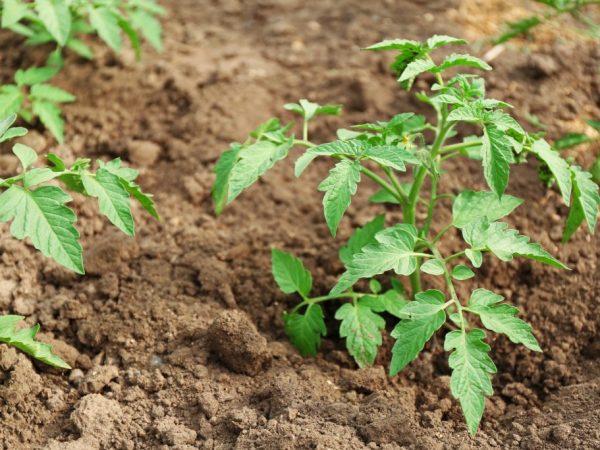

Tomatoes need good care
To grow seedlings of Abakan tomatoes, you first need to prepare the seeds. To do this, you need to pour them into a glass and fill them with salt water (50-60 ° C). For sowing, those that remain at the bottom of the container are suitable. Then they need 15 minutes. keep in a weak solution of potassium permanganate for disinfection. After that, you can start preparing the soil.
Disembarkation scheme
Mix garden soil with humus or peat, river sand in proportions of 2: 1: 1, respectively. Next, the soil is poured into containers and recesses are made on its surface (2 cm). Spread the seeds over the top layer at a distance of 2.5 cm from each other and sprinkle with a layer of earth no more than 0.5 cm in height.
Water the crops, but so as not to deepen the planting material. Use a spoon for this.
():
The soil should already be moistened before sowing.After sowing the seeds, only the top layer (1-2 cm) is moistened with water.
Care
It is recommended to sow seeds for seedlings 55-65 days before planting in open ground. A pick is performed when the plants already have 2-3 true leaves. Choose the sunniest place. Try to keep it at a temperature of 25 ° C. At night, this figure should be at least 18 ° C.
Use a film to speed up the appearance of seedlings. It is covered with seedlings until the emergence of shoots. Every day we need airing. 15 minutes will be enough. A spray method is suitable for watering. It is better to perform it with a frequency that does not allow the formation of a crust on the soil surface.
The culture should always have access to sunlight, so it is better to buy special lamps for the night time.
():
The total duration of daylight hours for tomatoes at the stage of growing seedlings should be at least 12 hours. In early spring, when the length of the day is 9-10 hours, the seedlings should be illuminated with a lamp for another 2-3 hours.
Transfer to the ground
For transplanting into the ground, those plants that have reached a height of 25-30 cm are suitable. The main thing is that by this time the soil has been fertilized. To do this, first dig it well, and then add peat - 2.5 kg per 1 m², provided that the digging depth is 20 cm. Further, holes are made in the soil at a distance of 40 cm from each other. Row spacing - 60 cm, depth - on a shovel bayonet.
Try to distribute the root system evenly over the hole. Do not plant the tomato too deep: the leaf growth line should be above the ground. After that, fill the grooves with soil and water (0.5-1.0 liters of water per plant). After 10 days, you can re-moisten the culture.
():
According to the planting rules, the planting holes are first spilled with water, after the water has been absorbed, the roots of the seedlings are lowered there and the holes are covered with earth with light compaction to create contact between the soil and the roots.
Tomatoes need proper care for normal development. Pay particular attention to the regularity of watering and pinching.
Loosening and weeding of the soil will also be important elements. Don't forget about feeding. It is important that they are carried out in a timely manner and the plant receives all the trace elements it needs.
Watering
Water the tomato once a week. During precipitation, irrigation is temporarily stopped, and in their absence, it is increased up to once every 4 days. The plant loves abundant watering: up to 5 liters of water should be consumed per plant.


Plants are watered with exceptionally warm water
Before flowering, the procedure is performed twice a week. When the first fruits are formed - every 3 days (3 liters). When the fruits begin to ripen, the frequency is reduced to once a week.
Loosening and weeding
After each watering, the soil is cultivated - loosening and weeding. Such procedures are necessary to ensure good air circulation. It is important that oxygen is supplied to the root system as well.
This prevents stagnation of water in the ground. The plant will receive all the substances it needs. Insect pests will not remain in the soil. Loosening helps prevent disease.
():
Only the top layer of the soil (4-5 cm) is loosened. Deep loosening can damage the roots, and pathogens of root rot, verticillium and fusarium wilting can enter the plant through the wounds.
Stepson and garter
Passionking is an indispensable part of caring for this variety. It is necessary to form a bush in no more than 2 stems. Leave one stepson and delete the rest. This procedure is performed regularly. It is important to monitor the condition of the shoots. Remove all weak ones at once, the same applies to the leaves.
Since heavy tomatoes grow on the bushes, garters will be difficult to do without. Bushes are tied to pegs so that the latter are a high-quality support. They should not harm the root system, so it is best to prepare and install them before you plant the seedlings in the soil.
Top dressing
The first top dressing should be carried out 14 days after planting the seedlings in the ground. The second is performed during flowering. The third is when fruiting. In the first case, prepare a solution based on ammonium nitrate (20-30 g per 10 liters of water) .. Consumption per bush is up to 1 liter.
For the second fertilizer, it is better to take chicken manure (500 g) and potassium sulfate (1 tsp) and dilute the mixture in 10 liters of water. Consumption - 1 liter per plant. For the third feeding, mullein (500 g) and nitrophoska (1 tbsp. L.) Are suitable. Feed the culture at the rate of 1 liter per bush.
Features of growing and care
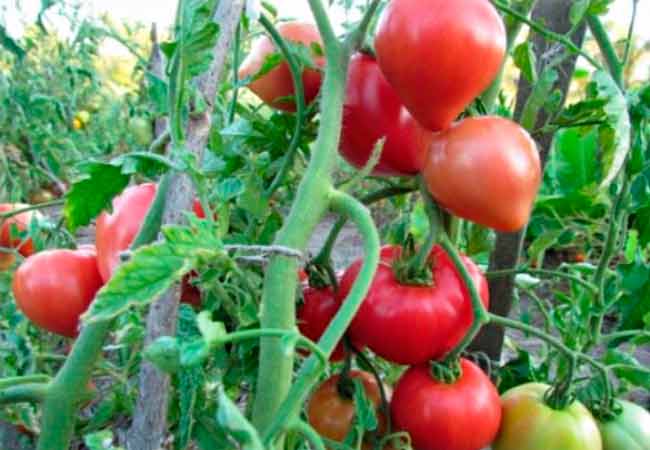

Among novice gardeners, there is an opinion that growing tall varieties of tomatoes is troublesome. In fact this is not true. Anyone who has ever planted an Abakan pink tomato in his garden can be convinced of this. This is a variety that you can try to grow a couple of these tomatoes on the balcony if you want.
According to experienced gardeners, seedlings tend to stretch. In order to avoid this unnecessary phenomenon, sowing is additionally illuminated with neon lamps.
For the tomato to produce maximum yields, plant it in loose, very fertile soil. Even before planting seedlings in the ground, fertilize abundantly with organic matter, humus or compost. The second indispensable condition for high yields is that the soil under these tomatoes should always be moist.
If your garden does not have loose soil, then you should work a little to artificially create it. Add some coarse sand to each hole. If the soil is acidic, add wood ash or dolomite flour while digging up the beds.


Start preparing the soil a week before planting the tomatoes. First of all, water it abundantly, make markings for future holes. The distance between holes and rows should be at least 35-40 cm.
If the bushes are planted closer to each other, then they will not have enough nutrients, the harvest, respectively, will turn out to be meager. The best option is to plant three bushes on one square meter of land. At the place where the holes are marked, you must immediately drive the stakes into the ground.
Plant seedlings in the evening. Too long sprouts should be planted at an angle; cover most of the stem with earth. After planting, water each bush abundantly, after a week, do not moisten the soil. Cover the wells with a layer of mulch to retain moisture.
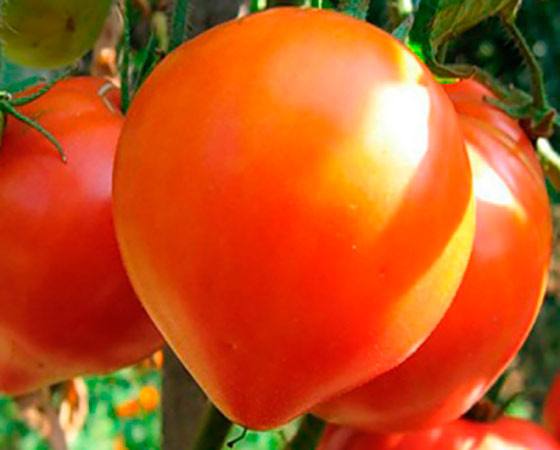

Abakan pink tomato actively launches additional trunks, on which branches are also formed. If you do not limit the number of new trunks, then the stems of the tomatoes will occupy the entire garden. To get the largest tomatoes possible, leave one or two trunks on each bush. Cut the rest to the root. Each of them will soon have 6 branches with small tomatoes.
Tomatoes need organic and mineral fertilizers. Fertilize the soil at least three times over the summer. Plus, water the tomatoes with a weak solution of boric acid or iodine twice a season. This folk recipe is said to be very effective in terms of tomato yield.
If you fertilize the soil with potassium magnesium at the beginning of the ripening of tomatoes, then the fruits will acquire a slightly sweetish taste.
The tomato bush needs regular watering. In greenhouses, moisten the soil every 5 days, and in the beds as needed. Water the tomatoes in the evening. If this is done in the heat, then the leaves will immediately wither.
It is necessary to monitor the soil between the tomato rows - loosen it, weed out the weeds.
If you strictly follow all of the above rules of care, then from each square meter you will receive at least 4 kg of wonderful fruits.
Disease and pest control
According to the description of the Abakan pink tomato, it has excellent disease resistance, but a little prevention will not be superfluous. To carry it out, use a solution of 75 g of lime, 100 g of vitriol and 10 liters of water.Bushes are processed 2-3 times during the entire growing season. In this case, the consumption is no more than 200 ml per 1 m².
Of the pests, the Colorado potato beetle is the most dangerous. Garlic tincture and wood ash are especially effective against it.
In the first case, 1.5 kg of crushed cloves are poured with water (10 l) and 2 g of potassium permanganate is added. Consumption - 500 ml per bush. It is necessary to process tomatoes with a solution every 2 weeks from the moment the ovary appears.
Wood ash is used in different ways. It can be sprayed with a plant or sprinkled with a substance around the bushes. In the first case, add 100 g of the substance to 10 liters of water and leave for 3 hours. Consumption per plant is 500 ml. To cultivate the soil, you will need about 50 g for each of the bushes.



